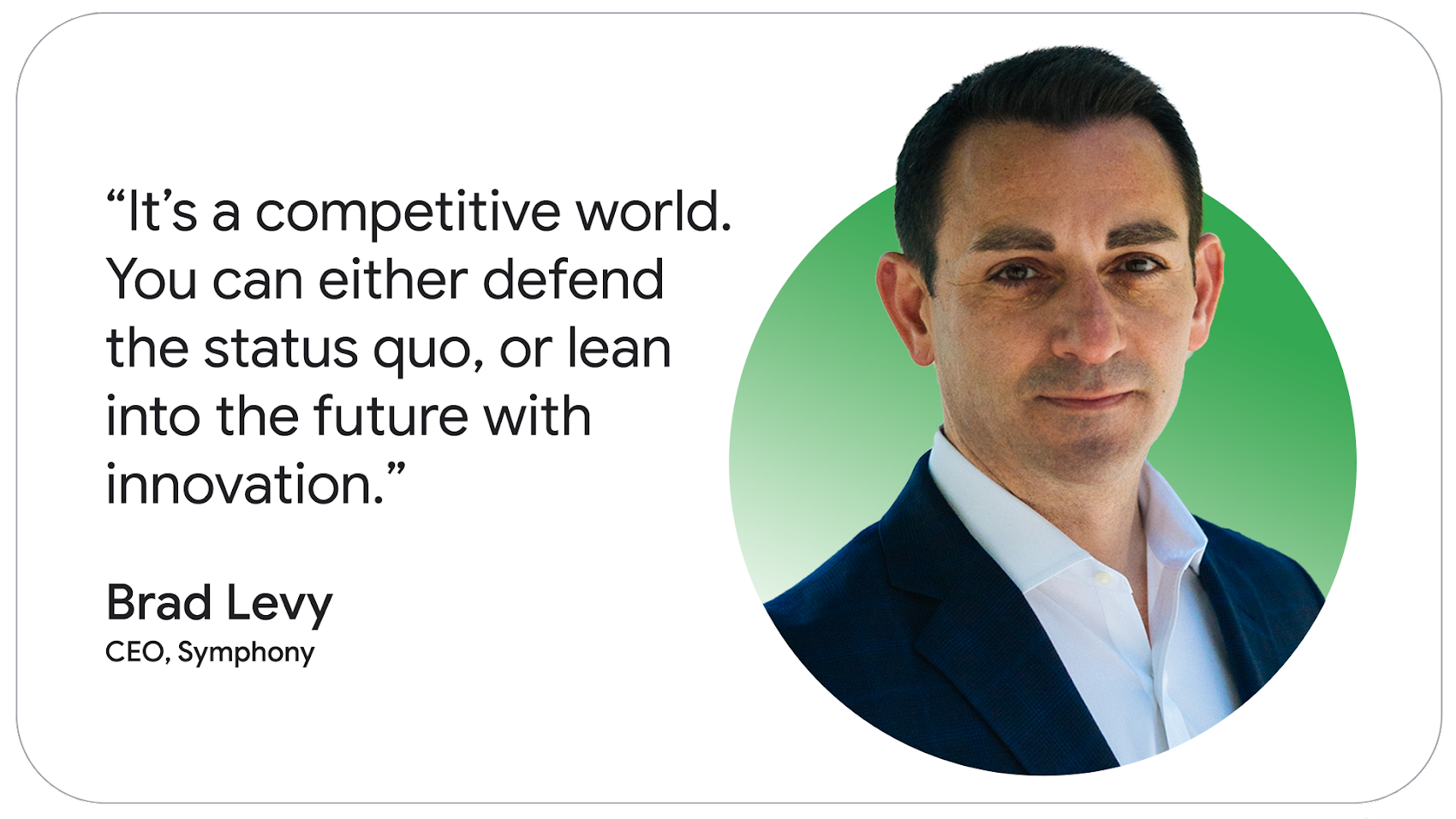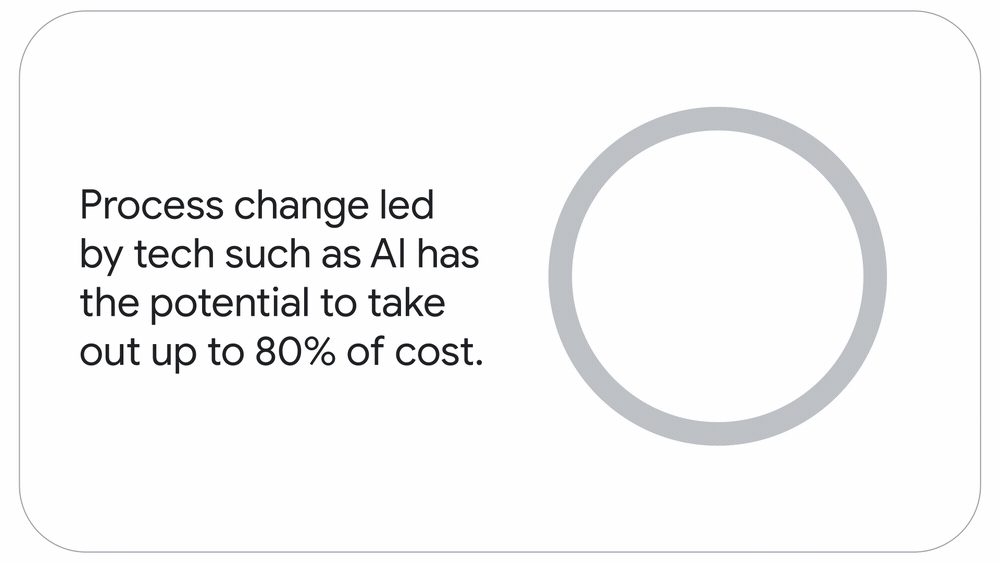The future of industries: What's happening now and next in financial services

Yolande Piazza
VP, Financial Services, Google Cloud
Brad Levy, CEO of Symphony, discusses how generative AI and cloud technologies are continually reshaping financial services.
As the world becomes increasingly interconnected and data-driven, the financial services industry finds itself at the forefront of technological innovation. With the recent advancements in generative — or gen — AI, the complexities of managing assets, risk, and client interactions are being revolutionized, allowing for more sophisticated analysis and tailored solutions. The power of data and AI is poised to uncover valuable insights and drive actionable outcomes, empowering financial institutions to make informed decisions and unlock new sources of value for their customers.
“We've been on a precipice of change in how financial services companies will run and operate, and the momentum will only accelerate,” said Brad Levy, chief executive officer at Symphony, which launched in 2014 as a messaging platform to solve data security and compliance challenges. Today, his company describes itself as “the common connector for market workflow,” serving more than half a million users and 1,000 financial institutions.
Levy is no stranger to fostering innovation and tackling inefficiencies in the financial markets, having spent years at IHS Markit and Goldman Sachs before taking the lead at Symphony. He has received industry recognition for his dedication to driving change as a global leader in financial services, and believes that the scale and velocity of change will be dramatic in the next five years. “It’s a competitive world — you can either defend the status quo, or lean into the future with innovation,” he said.


Levy sat down with Yolande Piazza, vice president for financial services at Google Cloud, to talk about the challenges and opportunities that financial services organizations face as they leverage cloud, data science, and AI to add value across offerings and operations.
What do you think your customers will demand of this industry over the next three to five years?
I think there’s more of a growing movement towards the user experience and how consumers interact with data, applications, and people. We can learn a lot from the consumer. In financial services, we tend to think of a client as an organization rather than as individuals, and we tend to be more pinned to the desktop. Financial institutions will need to think in a mobile sense, and understand that mobility is connected to better individual user experiences. I see a shift towards tailoring technology and solutions to meet the needs of specific markets and individual users in the front, middle, and back offices. There are hundreds of personas whose needs are not being met, from people in equity trading to those settling loans.
What are the biggest trends you see shaping the future of financial ecosystems?
The volatility of value is a big concern for financial institutions as they see how they have been spending their money over the last 20 years. Money is not free and the industry is getting tight on cost. It’s hard to invest in something when its value is elusive or opaque—whether it’s the value of data and data science, the value of your company, the value of a startup you’re betting on that could fail, or the value of the portfolio of your assets that look like they may be overvalued.
There’s also more complexity of talent and problems to solve, and everything is more connected like a montage rather than stacked on top of each other like Tetris. People and talent therefore need to be more diverse, so we have to think differently about how we manage talent across the industry.
I see a shift towards tailoring technology and solutions to meet the needs of specific markets and individual users in the front, middle, and back offices.
How do you see the role of technology shaping the future of this industry?
I’ve been in and around data for 30 years now, and AI is already a couple of decades into its development and is now in the consumer space. But all technology has good and bad, light and dark aspects, and AI does as well. It’s a balancing act, and we need to engage and figure out ways to make it more secure.
We think we could be one of these secure access points for certain types of AI-led applications and gen AI. Also, I think SLMs, or small language models—really tailored and targeted models—will grow and be connected to each other versus one giant large language model. And I think we’ll provide part of that access, and be part of the fabric and human-to-bot database movement over the next five years.
What is a specific use case where gen AI could provide value to the industry?
In today’s macroeconomic environment, cost management and effective processing will be amongst the first business use cases in regulated industries. For example, gen AI can augment human insight to rapidly scale the speed and quality in decision making in financial services.
I also see many opportunities for gen AI to increase developer productivity and improve resolution of customer issues with conversational AI agents. Gen AI adoption will happen quickly, starting with small pilots such as these, and build in complexity over time.




How are you partnering with financial services institutions to think about how they can get on this journey?
We think we could be an access point for other platforms in the market that are more institutional, with the ability to marry up private data with high compute. Increasingly, we’re embedding our application in other applications via what we call Embedded Collaboration Platform, or ECP, and also allowing applications to exist in Symphony as well as an app. And then we hope to have a lot of interactions between all of those.
We’re also looking to embed ourselves in other environments that are more data-led, with AI or gen AI in a portal that's not necessarily ours, but Symphony could be there helping to share that information and interact with it, and bring you there through alert and workflow push. That’s where it gets more interesting, with Symphony as the fabric of AI that rolls out into the industry.
I expect to see more consolidation and disruptions that are bigger and more dramatic, where we’ll see companies you’d never expect to merge get together, which could lead to mass platforms.
What is your boldest prediction of a shift in financial ecosystems?
In the next three to seven years, I expect to see more consolidation and disruptions that are bigger and more dramatic, where we’ll see companies you’d never expect to merge get together, which could lead to mass platforms. Digital assets will become more relevant as paper, property, trades, and swaps will start to be tokenized, which will be very disruptive.
I often consider the interconnectedness of technology with the dimensions of cost, revenue, risk, and customer experience. We are in a cycle now where cost matters. Process change led by tech such as AI has the potential to take out up to 80% of cost. Of the 80% saved, I predict organizations will reinvest 50% of cost savings back into the organization.
In terms of gen AI adoption, I think it will happen quickly but in small ways. Operations and exception management, ESG, surveillance, compliance, and anywhere you need to target problem people are ripe use cases for gen AI for the next 18 months since they’re preventative rather than look-back. Then gen AI will become more predictive, and more use cases for revenue, risk, and customer experience will emerge.


What made Symphony consider working with Google Cloud?
I consider Google to be the best data company on the planet, and it has an amazing handle on security. Symphony thinks a lot about security and resiliency, and we wanted to strategically partner with Google Cloud to harness data in a fast, safe, and compliant way. We want to be more connected and collaborative in the future, and Google Cloud is helping us to achieve that as we look to leverage clouds across regions.
It’s important to us that they are extending their focus on security and responsible AI principles to generative AI as well. Our clients feel strongly about security and we want to ensure they have complete control over their data. We can feel confident working with Google Cloud on generative AI knowing the technology offers the user security, data management, and access controls we’ve experienced across their other products.
What advice would you give to financial services industry executives looking to transform?
Get curious and look around you. If you don’t see what you’re looking for, then look somewhere else. Drive a diverse team and apply knowledge in practical ways. And be aware of the time limit when it comes to buy-in: If a project isn’t done in a quarter or a year, then no one in your firm will care. Few companies are building anything 18 months out as much as they used to.
Also, competition drives innovation. Infrastructure shouldn’t be run like islands, so at the same time, we all need to partner with each other. The movement of finance and technology is finally happening. Let’s enable it across the entire industry.
Header image created with Midjourney, using the prompt "The future of finance."



